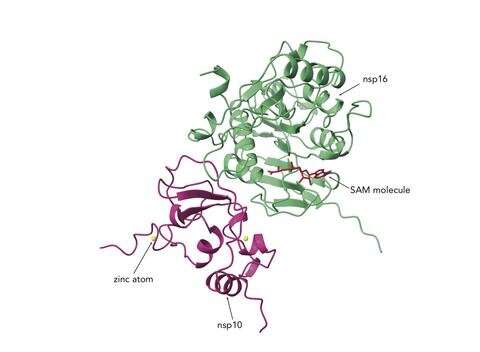
A new potential drug target has been identified in SARS CoV-2—the virus that causes COVID-19—by scientists at the Center of Structural Genomics of Infectious Diseases, or CSGID, who say multiple drugs will be needed to treat the pandemic.
CSGID scientists mapped the atomic structures of two critical SARS-CoV-2 proteins in a complex called nsp10/16. CSGID is an international consortium of scientists investigating the structure of the coronavirus proteins to in aid drug development, and includes Adam Godzik, a professor of biomedical sciences at University of California, Riverside’s School of Medicine.
The two proteins modify the genetic material of the virus to make it look more like the human RNA, allowing it to avoid host anti-viral defenses and giving it time to multiply. The researchers believe if a drug can be developed to inhibit nsp10/nsp16, the immune system should be able to detect the virus and eradicate it faster.
“We first designed the constructs—pieces of DNA— to express the two proteins,” Godzik said. “Subsequently, we analyzed the structure of these proteins.”
Protein production, purification, crystallization and structure determination work for the drug test was performed at Northwestern University, the University of Chicago, and Argonne National Laboratory.
Godzik said the research team is releasing the protein structures to the public, so other research groups can use them for drug discovery efforts.
“This is a really beautiful target, because it’s a protein absolutely essential for the virus to replicate,” said lead investigator Karla Satchell, a professor of microbiology-immunology at Northwestern and CSGID director.
Satchell’s team is sending the new protein complex to Purdue University, the drug-discovery site of the center, to be screened for novel inhibitors that could be developed as new drugs.
The nsp10/nsp16 protein complex is called an RNA methyltransferase or MTase. It is comprised of two proteins bound together. The association of the two pieces together is required to make a functional protein, according to prior research on SARS.
This is the fourth protein structure of potential drug target of SARS-CoV-2 determined by the CSGID team of scientists.
“We need multiple drugs to treat this virus, because this disease is likely to be with us for a long time,” Satchell said. “It’s not good enough for us to develop a single drug. If COVID-19 develops a resistance to one drug, then we need others.”
Structures of three other proteins important for the replication of the virus were also released: the nsp15 endonuclease, nsp3 ADP ribose phosphate, and nsp9 replicase. These structures were determined by the CSGID scientists working at the University of Chicago, headed by Professor Andrzej Joachimiak, a distinguished fellow at Argonne, and an adjunct professor at Northwestern. All work conducted by both the University of Chicago and Northwestern teams was designed by Godzik’s bioinformatic team, based on research conducted on SARS.
“This is all part of an effort to map the entire protein structural repertoire on the new virus,” Godzik said. “Expanding the structural coverage by solving additional structures is the most immediate follow-up direction. The second direction is co-crystallization experiments with potential drugs; we want to know if and how the coronavirus proteins bind to them. This would help to improve the drugs, making them better geared toward this particular pathogen.”
CSGID is racing to release more structures for drug development. The center’s goal is to determine structures of all of the proteins that are potential drug targets. The team is also collaborating to provide proteins to investigators for designing improved vaccines.
“The center has shown a great ability to bring structure biology to the scientific community at an unprecedented rate,” Satchell said.
The center’s work has become more challenging because many universities have reduced activities and some labs have shut down entirely.
Source: Read Full Article
